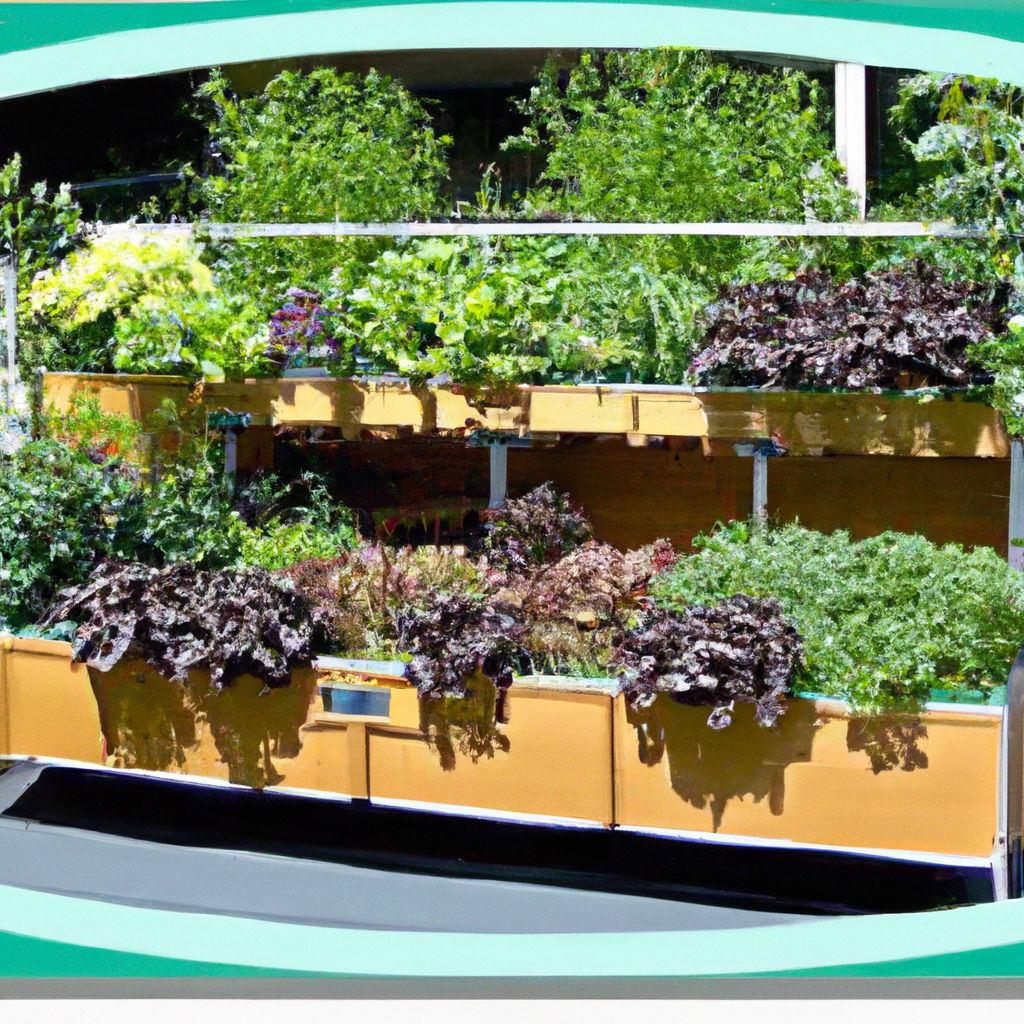
In “Maximizing Yield: Space-saving Techniques for Vertical Gardening in Urban Areas,” you will discover an array of innovative ideas to optimize your gardening space in urban environments. From utilizing vertical structures to selecting compact plant varieties, this article offers practical tips and techniques to maximize your yield while making the most of limited space. Whether you have a small backyard, a balcony, or even a tiny rooftop, this guide will provide you with the tools to create a flourishing garden oasis in the heart of the city.

Maximizing Yield: Space-saving Techniques for Vertical Gardening in Urban Areas
Vertical gardening is an innovative solution for individuals living in urban areas with limited space. With the right techniques and strategies, you can create a thriving garden that maximizes yield while taking advantage of limited vertical space. In this article, we will explore various space-saving techniques for vertical gardening in urban areas, from designing an efficient vertical garden to utilizing walls and fences for plantings.
Designing an Efficient Vertical Garden
To maximize the potential of your vertical garden, it is important to design it efficiently. Here are some key factors to consider when designing your vertical garden:
Assessing Available Space
Before starting your vertical garden, assess the available space you have. Look for walls, fences, balconies, or any vertical surface that can be utilized for plantings. By understanding the available space, you can plan accordingly and choose the right plants and structures.
Choosing the Right Vertical Structure
Selecting the appropriate vertical structure is crucial for a successful vertical garden. Options include trellises, supports, wall pockets, or modular wall planters, among others. Consider the weight, stability, and durability of the structure to ensure it can support the weight of the plants and withstand various weather conditions.
Planning for Plant Density
When planning your vertical garden, consider the density of plants. Opt for compact and dwarf varieties that require less space but still provide abundant harvests. By strategically arranging the plants, you can maximize the number of plants in your vertical garden and increase your yield.
Consideration of Wind and Sun Exposure
Wind and sun exposure play important roles in the success of your vertical garden. Take note of the direction and strength of the wind in your particular location. Place more delicate plants in areas that receive less wind. Similarly, consider the sunlight requirements of your plants and position them accordingly to ensure optimal growth.
Incorporating Multiple Tiers in the Design
To further maximize space, consider incorporating multiple tiers in your vertical garden’s design. Utilize hanging planters, shelves, or platforms to create different levels for plantings. This not only enhances the aesthetics but also increases the overall capacity of your vertical garden.

Choosing the Right Plants for Vertical Gardening
Selecting the right plants is essential for successful vertical gardening. Here are some factors to consider when choosing plants for your vertical garden:
Selecting Compact and Dwarf Varieties
Compact and dwarf varieties are ideal for vertical gardening as they take up less space while still producing a bountiful harvest. Look for varieties specifically bred for container gardening or vertical growing. These plants tend to have smaller growth habits, making them perfect for maximizing space.
Choosing Climbing and Vining Plants
Climbing and vining plants are excellent choices for vertical gardening, as they utilize vertical space effectively. Examples include tomatoes, cucumbers, and peas. These plants can be trained to grow vertically, allowing you to maximize your available space while still enjoying a variety of produce.
Identifying Shade-Tolerant Plants
Not all areas of your vertical garden will receive direct sunlight throughout the day. Identify shade-tolerant plants that can thrive in areas with less sunlight. Lettuce, spinach, and herbs like mint and parsley are excellent choices for these shadier spots.
Considering Edible Plants for Urban Vertical Gardens
If you’re looking to create an edible vertical garden, consider growing vegetables, herbs, and fruits. Tomatoes, peppers, strawberries, and herbs like basil and rosemary are popular choices. These plants not only provide a delicious harvest but also add beauty and vibrancy to your urban space.
Mixing Plants for Aesthetically Appealing Designs
Besides considering the practical aspects, such as plant size and growing habits, don’t forget to design your vertical garden for visual appeal. Mix plants with different colors, textures, and heights to create an aesthetically pleasing garden. This will enhance your urban space and make your vertical garden a delightful sight to behold.
Optimizing Lighting for Vertical Gardens
Lighting is a crucial factor in the success of any garden, including vertical gardens. Here are some tips for optimizing lighting in your vertical garden:
Assessing Natural Light Availability
Start by assessing the natural light availability in the designated area for your vertical garden. Note the direction the sun shines and the number of hours of direct sunlight the area receives. This will help you determine which plants will thrive in the specific lighting conditions.
Supplementing with Artificial Lighting
In urban areas, natural light may be limited, especially if you have tall buildings or shady locations. Consider supplementing natural light with artificial lighting, such as grow lights. LED grow lights are energy-efficient and can provide the necessary light spectrum for plant growth.
Choosing the Right Light Spectrum
Plants require different light spectrums for various stages of growth. Some plants thrive with a full spectrum light, while others may require a specific spectrum. Research the light requirements of your chosen plants and select a lighting system that provides the appropriate spectrum for optimal growth.
Positioning Lights for Maximum Coverage
When using artificial lighting, pay attention to the positioning of the lights. Position them at an appropriate distance from the plants to ensure even and adequate coverage. Avoid placing the lights too close, as this can cause heat stress, or too far, as it may limit light absorption.
Managing Light Duration and Intensity
Ensure you manage the duration and intensity of the lighting in your vertical garden. Different plants have varying light requirements, so adjust the duration and intensity according to their specific needs. Some plants may require longer periods of light, while others may need a shorter duration.

Watering Strategies for Vertical Gardens
Proper watering is essential for the health and growth of plants in a vertical garden. Here are some effective watering strategies to implement in your vertical garden:
Drip Irrigation Systems for Vertical Gardens
Drip irrigation systems are highly efficient and ensure water is delivered directly to the plant’s root zone. For vertical gardens, implementing a drip irrigation system can help conserve water and reduce the risk of overwatering or underwatering. The system can be set on timers, ensuring consistent and adequate hydration for your plants.
Utilizing Self-Watering Containers
Self-watering containers are another effective strategy for watering vertical gardens. These containers have a built-in reservoir that automatically waters the plants as needed, reducing the frequency of manual watering. This is particularly beneficial for individuals with busy schedules or those who may forget to water their plants regularly.
Implementing Irrigation Timers
Timers can be added to your watering system, ensuring a consistent watering schedule for your vertical garden. This helps prevent under or overwatering, ensuring plants receive the necessary amount of water at the appropriate intervals. Set the timers based on the plants’ specific water requirements.
Choosing the Right Watering Technique for Each Plant
Different plants have varying water requirements. Some plants may prefer moist soil, while others thrive in drier conditions. Understanding the watering needs of your chosen plants and adjusting your watering technique accordingly will help ensure optimal growth and prevent water-related issues.
Monitoring Moisture Levels and Adjusting Accordingly
Regularly monitor the moisture levels of your soil or growing medium and adjust watering accordingly. This is especially important in vertical gardens, as water drainage may differ from traditional gardens. Avoid overwatering by allowing the soil to dry slightly between watering, preventing root rot and other moisture-related problems.
Utilizing Vertical Space with Trellises and Supports
Trellises and supports are fantastic tools for utilizing vertical space effectively in your garden. Here are some tips for using them in your vertical garden:
Installing Sturdy Trellises and Supports
When incorporating trellises and supports in your vertical garden, ensure they are sturdy and capable of supporting the weight of climbing and vining plants. Consider materials like metal or wood, which are durable yet visually appealing. Proper installation is crucial to prevent accidents or damage to your plants.
Training Plants to Grow Vertically
To make the most of trellises and supports, train your plants to grow vertically. Gently guide the plants’ growth by weaving the stems around the support system. Regularly check for new growth and redirect it as necessary to ensure the plants remain trained and grow in the desired direction.
Implementing Espalier Techniques
Espalier is a technique in which plants are trained to grow flat against a wall or structure. This technique saves space and provides a visually striking display. Fruit trees, such as apples and pears, are commonly trained using espalier techniques. With regular pruning and training, your vertical garden can resemble a beautiful work of art.
Creating Ladder or Net Systems
Consider creating ladder or net systems to support climbing plants that do not naturally cling to structures. These systems allow the plants to climb and spread, making the most of your vertical space. Install the ladder or net systems securely to ensure stability and longevity.
Utilizing Adjustable Tension Rods for Climbing Plants
Adjustable tension rods are versatile tools that can be used to create vertical growing space. Many climbing plants, such as beans and peas, can be trained to climb up tension rods, making them ideal for small vertical gardens. Install the rods securely and adjust them as your plants grow, providing continuous support.

Using Hanging Planters for Vertical Gardening
Hanging planters offer a unique and practical way to utilize vertical space in your garden. Here are some tips for using hanging planters effectively:
Choosing the Right Hanging Planter Materials
Select hanging planters made from materials that are lightweight, durable, and weather-resistant. Options include plastic, metal, or fabric planters. Consider the overall weight of the planter when filled with soil and plants to ensure it can be safely hung.
Selecting Appropriate Hanging Planter Sizes
Choose hanging planters that are appropriate for the plants you intend to grow. Some plants require deeper planters, while others can thrive in more shallow ones. Ensure the planter provides adequate space for the roots to grow and allows for proper drainage.
Creating Tiered Hanging Planters
To maximize vertical space, create tiered hanging planters. Hang multiple planters at different levels to display an array of plants. This not only provides a visually appealing garden but also maximizes the number of plants you can grow within a limited area.
Organizing Plants for Maximum Visual Impact
When arranging your plants in hanging planters, consider their growth habits, colors, and textures. Arrange complementary plants together to create visually striking displays. The combination of trailing and upright plants can create a lush and vibrant vertical garden that is pleasing to the eye.
Ensuring Adequate Drainage for Hanging Planters
Proper drainage is crucial for the health of your plants in hanging planters. Choose planters with drainage holes or add drainage layers at the bottom to prevent waterlogging. Ensure there is a way for excess water to drain freely to avoid root rot and other water-related issues.
Utilizing Walls and Fences for Vertical Gardening
Walls and fences provide excellent opportunities for vertical gardening in urban areas. Here are some tips for utilizing them effectively:
Installing Vertical Garden Pockets on Walls
Vertical garden pockets are specially designed planters that can be attached to walls and fences. These pockets have spaces for individual plants, allowing you to create a lush and vibrant garden without taking up valuable floor space. Install them securely and consider alternating plant varieties for an attractive vertical display.
Choosing Climbing Plants for Walls and Fences
Climbing plants are natural choices for vertical gardens on walls and fences. Choose plants with strong climbing habits that can attach themselves to the vertical surface. Options include ivy, jasmine, or climbing roses. Keep in mind the height and spread of these plants to ensure they do not overwhelm the space.
Implementing Modular Wall Planters
Modular wall planters are an excellent solution for individuals with limited space. These systems consist of individual planting cells that can be arranged and attached to a wall or fence. With these planters, you can create custom vertical gardens that suit your preferences and available space.
Utilizing Vertical Wall Gardens for Herbs
Vertical wall gardens are particularly well-suited for growing herbs. Install a vertical wall garden near your kitchen or outdoor cooking area to have fresh herbs readily available. Plant herbs like basil, thyme, and mint in the pockets or modular planters, providing you with a constant supply of aromatic and flavorful additions to your dishes.
Creating Privacy Screens with Vertical Plantings
Incorporating vertical plantings on walls or fences can also serve as privacy screens in urban areas. Choose tall, dense-growing plants like bamboo or dense ivy varieties to create a green partition between you and adjacent spaces. Enjoy increased privacy and a refreshing green environment simultaneously.

Vertical Hydroponic Systems for Urban Gardens
Hydroponic systems offer an efficient and space-saving solution for urban vertical gardens. Here are some tips for utilizing vertical hydroponic systems effectively:
Understanding Hydroponics for Vertical Gardening
Hydroponics is a soil-less method of gardening that uses water-based nutrient solutions to nourish plants. Vertical hydroponic systems take this method to new heights, enabling you to grow plants vertically without the need for soil. This approach maximizes space and allows for year-round cultivation.
Choosing the Right Hydroponic System
Various hydroponic systems are available for vertical gardening, including nutrient film technique (NFT), aeroponics, and vertical towers. Each system has its own advantages and requirements. Research the different systems and select the one that best suits your space, plants, and budget.
Managing Nutrient Solutions and pH Levels
In hydroponics, plants receive their nutrients directly from the water system. It is essential to monitor and maintain the nutrient levels and pH balance to ensure healthy plant growth. Regularly check the pH levels and adjust them as necessary to provide the optimal conditions for your plants.
Optimizing Vertical Space in Hydroponic Setups
Vertical hydroponic systems are designed to maximize space efficiency. Take advantage of the vertical structure by arranging your plants in a way that utilizes the available space optimally. Ensure that each plant has adequate access to light and nutrients, allowing them to grow and thrive.
Monitoring and Preventing Plant Diseases in Hydroponics
As with any gardening method, hydroponics is not immune to plant diseases. Regularly monitor your plants for any signs of disease or pests. Implement preventative measures such as proper plant spacing, excellent air circulation, and maintaining a clean and sterile growing environment to minimize the risk of disease spread.
Utilizing Vertical Space in Small Containers
Vertical gardening is not restricted to large structures; it can also be accomplished in small containers. Here are some tips for maximizing vertical space in small containers:
Choosing Compact Plant Varieties
In small containers, it is essential to choose plant varieties that are compact and well-suited for confined spaces. Look for dwarf or miniature varieties that have been bred specifically for container gardening. These plants often have smaller root systems, making them perfect for small vertical containers.
Utilizing Hanging Containers
Hanging containers are an excellent option for small spaces. Utilize hanging baskets, pouches, or planters to suspend your plants, saving valuable floor or countertop space. Hang the containers securely, ensuring they are level and can support the weight of the plants and growing medium.
Going Vertical with Tiered Stands or Shelves
Maximize your vertical space by using tiered stands or shelves to hold multiple small containers. This allows you to grow multiple plants in one compact area. Ensure the shelves are sturdy and stable, with adequate space between each level for optimal growth and access to light.
Opting for Stackable Planting Systems
Stackable planting systems, commonly seen with herb gardens, provide a space-saving solution for small vertical gardens. These systems consist of multiple tiers that stack on top of each other, providing individual planting compartments. Stackable planting systems are perfect for growing herbs, small vegetables, or colorful flowers.
Utilizing Wall-Mounted Planters
Wall-mounted planters are an innovative way of utilizing vertical space in small containers. These containers can be attached directly to walls or fences, saving valuable floor space. Be sure to choose containers with proper drainage and consider varieties that are suited for vertical growing, such as trailing or cascading plants.
Maintaining and Pruning Vertical Gardens
Proper maintenance and pruning are essential for keeping your vertical garden healthy and productive. Here are some tips to help you maintain your vertical garden:
Regularly Inspecting and Maintaining Plants
Regularly inspect your plants for any signs of pests, disease, or nutrient deficiencies. Check the leaves, stems, and flowers for any abnormalities. Take necessary actions promptly, such as removing affected parts or treating with appropriate remedies, to prevent the spread of problems.
Pruning Techniques for Vertical Gardens
Pruning is essential for maintaining the shape, health, and productivity of your vertical garden. Trim back any dead, damaged, or diseased branches or leaves. Regularly prune to encourage bushier growth and prevent overcrowding that can impede sunlight and air circulation.
Training and Redirecting Plant Growth
Maintain control and direct the growth of your plants by training and redirecting them as they develop. Gently guide the plants to grow in the desired direction, such as upward towards a trellis or along a wall. Regularly monitor their growth and adjust as necessary to prevent overcrowding and ensure an attractive display.
Identifying and Addressing Pest Issues
Pests can wreak havoc on your vertical garden. Regularly check for signs of pests, such as chewed leaves or small holes. Identify the pests and use appropriate methods to eliminate them, such as organic insecticides or handpicking. Preventive measures, such as companion planting, can also help deter pests.
Preventing Weeds in Vertical Gardening
Weeds are unwelcome intruders that can compete with your plants for nutrients and water. Implement strategies to prevent weeds in your vertical garden, such as using weed barriers or mulching. Regularly remove any weeds that sprout, ensuring they do not take root and multiply.
By implementing these space-saving techniques, you can enjoy a thriving vertical garden in even the smallest urban areas. Whether you utilize trellises, hanging planters, or hydroponic systems, maximizing yield and utilizing vertical space has never been easier. With careful planning and maintenance, you can create a lush, productive, and visually appealing vertical garden that brings joy and beauty to your urban environment.





